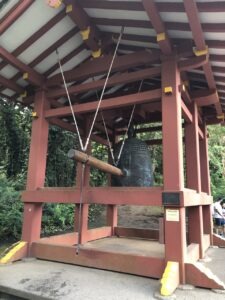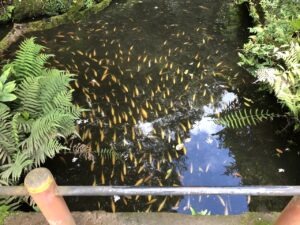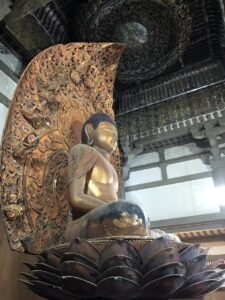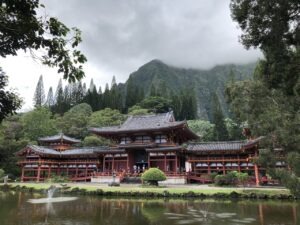I’ve heard it said that Hawaii is a place where East meets West. One of the most immersive examples of this can be experienced by visiting Byodo-In Temple in Kaneohe, O’ahu. Situated at the base of the Ko’olau Mountains, this stunning Buddhist temple was dedicated in 1968, commemorating the 100-year anniversary of the arrival of Hawaii’s first Japanese immigrants. With its beautiful sanctuary, architecture, and grounds, this sacred space invites reflection and contemplation.
The temple is a scaled-down replica of the Byodo-in Temple in Japan, which dates back to the 11th century. The Hawaii version is about 50% smaller and is actually part of a large cemetery complex known as the Valley of the Temples Memorial Park. Byodo-In is a non-practicing, non-denominational temple that welcomes all faiths. This hospitable approach seems fitting given that “Byodo-In” translates to “Temple of Equality.”
Byodo-In is situated toward the back of the cemetery with parking nearby. After paying admission, you’ll cross a footbridge where you’ll be greeted by a stunning view of the temple, grounds, and the mountains behind. A zen garden and koi pond will be visible in front of the temple, and a bon-sho (sacred bell) is positioned along the left path. The bell, which was cast in Osaka, Japan, is over 6 feet tall and weighs in excess of 7 tons. Visitors are welcome to ring it using the shumoku (the hanging wooden log). The bon-sho’s sound is said have positive effects, such as bringing happiness and long life.
The temple itself, known as Ho-O-Do (Phoenix Hall), has two open-air wings that extend out to either side. There may be booths setup there. In the center is the sanctuary, which is a sacred space. You’ll need to remove your shoes and leave them in a cubby before walking in. If you’d prefer not to do that, there’s an outside path around the front of the sanctuary that will allow you to get a view inside without actually entering.
Within the sanctuary of Byodo-In is a magnificent statue of Amida Buddha. The carving is over nine feet tall and is covered in lacquer and gold leaf. The Buddha sits in meditation upon a lotus flower. His hands are in the Mida no Jōin position, which is a mudra (sacred hand position) used in Japan for images of Amida. In the middle of his forehead is a representation of his third eye, known as a byakugo. Around Amida are smaller images of bodhisattvas, which are enlightened beings who delayed becoming Buddhas in order to help others.
Amida Buddha is also known as Amitabha (“Infinite Light” in Sanskrit) and Amitayus (“Infinite Life” in Sanskrit). In the sacred texts of Pure Land Buddhism, it is said that Amida reigns over a paradise realm known as the Pure Land. Those who put their faith in Amida will be reborn there. Because of its idyllic nature and the proximity of Amida, followers who gain access to this place will easily achieve enlightenment and become boddhisattvas or Buddhas.
Not surprisingly, Hollywood has taken notice of Hawaii’s Byodo-In. It has appeared in a variety of TV shows including Hawaii Five-O, Magnum P.I., and Lost. It can also be seen in the 2001 film Pearl Harbor. So, there’s another layer enjoy at this site for fans of any of those programs.
Given everything I’ve discussed, it’s certainly not surprising that the temple is a popular spot for tourists. There may be some crowds when you go, so take that into account when planning your time. While there, you can also visit the gift shop, which has restrooms behind it. For the latest information on hours and ticket prices, please refer to their official website.
I found Byodo-In Temple to be a wonderful place to visit. The beauty and sacred nature of the space are quite impactful. For those looking to see another side of Hawaii, this site is not to be missed.
Location
47-200 Kahekili Highway
Kaneohe, HI 96744
Official site: byodo-in.com
Sources
“The Amida Buddha.” Byodo-In Temple, https://byodo-in.com/amida-buddha.htm.
Bloom, Alfred. “Amida Buddha and the Ideal of Universal Salvation.” Shin Dharma Net. https://bschawaii.org/shindharmanet/bloom/ab-writings/salvation/.
“Bon-sho (Sacred Bell).” Byodo-In Temple, https://byodo-in.com/bon-sho.htm.
Britannica, T. Editors of Encyclopaedia. “Daochuo.” Encyclopedia Britannica, January 1, 2022. https://www.britannica.com/biography/Daochuo.
“Byodo-In Temple – Valley of the Temples Memorial Park – Kaneohe, Oahu, Hawaii.” Byodo-In Temple, https://byodo-in.com/index.htm.
“Byodo-in Temple at Uji City.” Kyoto City Official Travel Guide. https://kyoto.travel/en/shrine_temple/124.html.
Crothers, Wayne. “Japanese Amida Buddha.” NGV, January 30, 2013. https://www.ngv.vic.gov.au/essay/japanese-amida-buddha/.
Hamblin, William and Daniel Peterson. “Encountering a landmark of Japanese Buddhism in Hawaii.” Desert News, July 21, 2017. https://www.deseret.com/2017/7/21/20616256/encountering-a-landmark-of-japanese-buddhism-in-hawaii.
Masters, Patricia Lee. “Byodo-in: A Place in the Pure Land.” Hawaii.com. https://www.hawaii.com/play/byodo-in/.
Muza-chan. “A Spiritual Look at the Great Buddha of Kamakura.” Muza-chan’s Gate to Japan, December 8, 2009. https://muza-chan.net/japan/index.php/blog/spiritual-look-great-buddha-kamakura.
Salguero, Pierce. “What is a bodhisattva? A scholar of Buddhism explains.” The Conversation, October 7, 2022. https://theconversation.com/what-is-a-bodhisattva-a-scholar-of-buddhism-explains-189366.
“Titles with Location Matching ‘byodo’ (Sorted by Match Descending).” IMDb, https://www.imdb.com/search/title-text/?location=byodo.
Written by A. P. Sylvia








